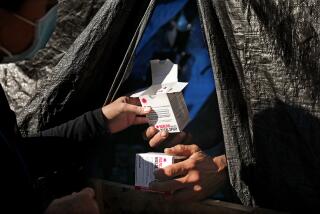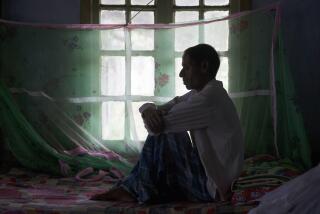340,000 With AIDS Virus Seen in L.A. County by ’91
- Share via
The initial draft of a long-awaited Los Angeles County study on the human and financial impact of the AIDS epidemic was released Friday with predictions that as many as 340,000 people in the county may be infected with the AIDS virus by 1991--far higher than any previous prediction.
The number of people actually afflicted with the disease, the report said, could be 44,000 by then, also much higher than previous estimates.
The report, prepared by a consulting firm and presented to the county’s Commission on AIDS, estimates that the current $32 million a year the county has committed toward AIDS programs may have to be tripled to cope with the epidemic over the next few years.
Although those figures would mean a price tag of hundreds of million dollars in AIDS-related care and education in the county, some AIDS commission members disputed that figure as far too conservative, predicting that the actual costs could wind up in the billions of dollars.
The report was critical of the county’s lack of success in educating high-risk groups, blaming a reluctance to “offend” the majority population by distributing explicit medical advice. Also inhibiting a proper response to the AIDS menace are the conservative attitudes of some members of the Board of Supervisors, according to individuals on the commission panel.
Rabbi Allen Freehling, chairman of the AIDS commission, defended the board but added: “This report points out, and not in an hysterical and panicky way, that we are facing a major problem with AIDS which some people have not yet acknowledged.
“There is a tremendous amount of avoidance in all of this: ‘It won’t happen to me; my family is not going to be affected.’ But what this report is going to say to everyone is that ‘You’re wrong. Your life is now affected by this epidemic whether directly or indirectly,’ ” Freehling said.
The report, which was prepared by the Peat Marwick Main & Co. consulting firm for the county Department of Health Services, is the most comprehensive county study of the ravages of acquired immune deficiency syndrome and suggests how local officials should deal with the disease over a five-year period. The draft report released Friday will be followed by a final version due April 1 and sent to the Board of Supervisors.
According to the latest health department statistics, there were 4,354 confirmed cases of AIDS in the county as of Jan. 31, including 2,722 who have died from the disease.
County health officials have estimated that 20,000 to 30,000 AIDS cases will be reported by 1991.
Predictions Grow
But the Peat Marwick study predicted that the number of diagnosed AIDS cases could actually number between 19,000 and 44,000 cases by 1991 and that an estimated 16,000 to 23,000 of those afflicted will have died by then. The firm’s estimate of the number of people infected with the AIDS virus--as opposed to those who have contracted the disease--ranges from 120,000 to 170,000 for 1987. By 1991, these numbers will grow to between 180,000 and 340,000, the report said.
The disparity between the lowest and highest estimate of AIDS cases appears in the consultants’ findings as a result of different means of estimating those likely to become victims.
The 19,000 number, not far from the county’s own estimate, is based solely on the rate at which the disease has increased in the county in the past. The higher figure of 44,000 was arrived at based on the size of the local population of those considered at high risk of the disease--mainly homosexual males and intravenous drug users--and estimates of the degree of infection within those groups. The study based those rates on research by the U.S. Public Health Service and UCLA.
Jan Ouren, of Peat Marwick, told the AIDS commission that projecting the number of possible AIDS victims in a high-risk group such as homosexual men has resulted in “a reasonable and conservative estimate.”
‘Tremendously Low’
However, commission member Eric Rofes said the estimate of the number of people at risk from AIDS and who will contract it is not merely conservative but is “tremendously low.”
Another member, Dr. Monroe Richman, also questioned the findings and said the total cost for AIDS care in the county could climb higher than $2 billion by 1991.
“This report isn’t to instill fear, but it is informative to show how many people are affected medically, personally and financially. The numbers are staggering,” said Robert Frangenberg, director of the county AIDS program office.
Some Conclusions
Among the conclusions in the draft report, which was done as part of a $114,500 contract, were findings that:
- The county’s educational program is “not yet effectively reaching high-risk populations” because the county is reluctant to “offend the majority of its constituents who do not participate in high-risk sexual activities and are not intravenous drug abusers.”
- Most individuals using county testing facilities do not receive post-test counseling or referral services upon presentation of test results, even if they test positive--a conclusion that county health officials disputed.
- There is a dearth of emergency and long-term residential housing for AIDS victims.
In addition, Peat Marwick warned that the county’s budget for medical care for AIDS patients “has doubled for each of the last three years, with no apparent end in sight,” and said that the rapid growth could result in “overloading” the county health system.
Urge Use of Vernacular
The firm recommended that the county provide educational materials targeted to particular high-risk groups and “written explicitly in their vernacular.” It also called for drug treatment alternatives to help intravenous drug users who are also at risk from AIDS.
Ouren told the commission that “the cry from the community” is that the battle against AIDS has become overly politicized in the county, especially in the area of education in which conservative members of the Board of Supervisors have balked at the use of sexually explicit material and pamphlets that are worded in street language.
That comment drew similar responses from several commissioners including Rand Schrader, the commission’s vice chairman, who said that county supervisors have presented “roadblocks” to efforts to deal with the AIDS crisis because of their disapproving views of homosexuals and other high-risk groups.
“This report says in as nice a way as you can and as tactful as a way as you can that the Board of Supervisors has dampened our ability in Los Angeles to reach the people who are affected by this infection, and it is imperative that the people in L.A. County . . . see how serious (the board’s) interference politically has been in treating a problem of life or death to people of Los Angeles,” Schrader said.
The only member of the board who could be reached, Pete Schabarum, declined to comment on the report.
More to Read
Sign up for Essential California
The most important California stories and recommendations in your inbox every morning.
You may occasionally receive promotional content from the Los Angeles Times.













